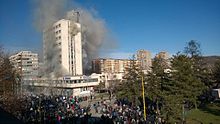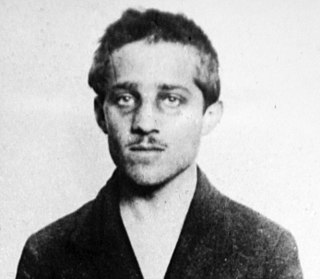
Gavrilo Princip was a Bosnian Serb student who assassinated Archduke Franz Ferdinand, heir presumptive to the throne of Austria-Hungary, and his wife Sophie, Duchess von Hohenberg, in Sarajevo on 28 June 1914. The killing of the Archduke and his wife set off the July Crisis, a chain of events that within one month led to the outbreak of World War I.

Young Bosnia was a separatist and revolutionary movement active in the Condominium of Bosnia and Herzegovina, Austria-Hungary before World War I. Its members were predominantly young male students, primarily Serbs, but it also included Bosnian Muslims and Croats. There were two key ideologies promoted amongst the members of the group—the Yugoslavist and the Pan-Serb. Philosophically, Young Bosnia was inspired by a variety of ideas, movements, theorists, and events, such as German romanticism, anarchism, Russian revolutionary socialism, Fyodor Dostoevsky, Friedrich Nietzsche, and the Battle of Kosovo.

Oskar Potiorek was an officer of the Austro-Hungarian Army, who served as Governor of Bosnia and Herzegovina from 1911 to 1914. He was a passenger in the car carrying Archduke Franz Ferdinand of Austria and his wife Duchess Sophie of Hohenberg when they were assassinated in Sarajevo on 28 June 1914. Potiorek had failed to inform the driver of a change of route which led the royal car to take a wrong turn, stalling after trying to turn around, and ending up in front of Gavrilo Princip. In World War I, Potiorek commanded the Austro-Hungarian forces in the failed Serbian Campaign of 1914. He was removed from command, retiring from the army shortly afterward.

Trifun "Trifko" Grabež was a Bosnian Serb member of the Black Hand organization which was involved in the assassination of Archduke Franz Ferdinand.

Muhamed Mehmedbašić was a Bosnian revolutionary and the main planner in the assassination of Archduke Franz Ferdinand, which led to a sequence of events that resulted in the outbreak of World War I.

Cvjetko Popović was a Bosnian Serb who was involved in the 1914 assassination of Archduke Franz Ferdinand of Austria.

Latin Bridge is an Ottoman-era bridge over the river Miljacka in Sarajevo, Bosnia and Herzegovina.
Serbs in Sarajevo numbered 157,526 according to the 1991 census, making up more than 30% of the ten pre-war municipalities of the Sarajevo metropolitan area: Centar, Stari Grad, Novo Sarajevo, Novi Grad, Ilidža, Ilijaš, Vogošća, Hadžići, Trnovo, and Pale.

The assassination of Archduke Franz Ferdinand was one of the key events that led to World War I. Archduke Franz Ferdinand of Austria, heir presumptive to the Austro-Hungarian throne, and his wife, Sophie, Duchess of Hohenberg, were assassinated on 28 June 1914 by Bosnian Serb student Gavrilo Princip. They were shot at close range while being driven through Sarajevo, the provincial capital of Bosnia-Herzegovina, formally annexed by Austria-Hungary in 1908.

The Museum of Sarajevo 1878–1918 is located near the Latin Bridge in central Sarajevo, the capital of Bosnia and Herzegovina. The building had been Moritz Schiller's Delicatessen in 1914, the year that Franz Ferdinand, the heir presumptive to the throne of Austria-Hungary was shot dead by Gavrilo Princip from the street corner outside, indirectly starting World War I.
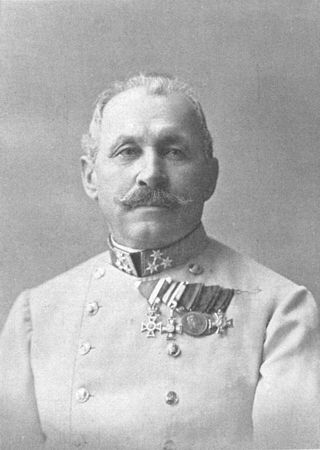
Marijan Varešanin von Varesch was a Croatian nobleman and general in the Habsburg monarchy imperial army service. He was the governor of Bosnia and Herzegovina from 1909 to 1911.

The anti-Serb riots in Sarajevo consisted of large-scale anti-Serb violence in Sarajevo on 28 and 29 June 1914 after the assassination of Archduke Franz Ferdinand. Encouraged by the Austro-Hungarian government, the violent demonstrations assumed the characteristics of a pogrom, which led to ethnic divisions that were unprecedented in the city's history. Two Serbs were killed on the first day of the demonstrations, and many others were attacked. Numerous houses, shops and institutions owned by Serbs were razed or pillaged.

Bogdan Žerajić was a Hercegovinian Serb student of the Faculty of Law at the University of Zagreb.

Vladimir Gaćinović was a Bosnian Serb essayist and revolutionary in Austria-Hungary. He was one of the leaders and organizers of the secret cells of the revolutionary movement Young Bosnia.

Mustafa Golubić was a Serbian, and later Yugoslav, guerrilla fighter, revolutionary and intelligence agent.

Sarajevo is a 2014 German-Austrian biographical television film that depicts the assassination of Archduke Franz Ferdinand of Austria.
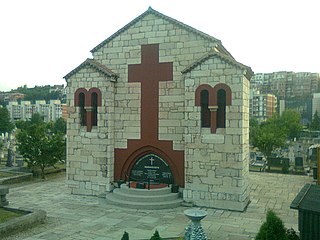
The Vidovdan Heroes Chapel is a Serbian Orthodox chapel and mausoleum located on the Holy Archangels Georgije and Gavrilo Orthodox Cemetery located in Sarajevo, Bosnia and Herzegovina.
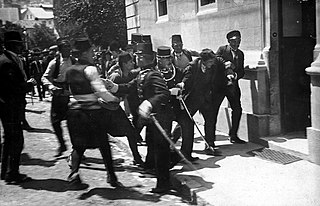
Arrest of a Suspect in Sarajevo, also erroneously known as The Arrest of Gavrilo Princip, is a historically significant photograph that captured the immediate aftermath of the assassination of Archduke Franz Ferdinand of Austria and his wife Sophie, Duchess of Hohenberg, in Sarajevo on 28 June 1914. Originally believed to depict the apprehension of the assassin, Gavrilo Princip, the image gained widespread attention after being featured prominently on the front cover of the Austrian weekly newspaper Wiener Bilder on 5 July 1914. This portrayal played a crucial role in generating patriotic sentiments that unified allied nations at the onset of World War I.
Walter Tausch was a 20th-century Austrian photojournalist, based in Sarajevo, who recorded the last images of Archduke Franz Ferdinand of Austria and his wife minutes before their assassination 28 June 1914, and documented the arrest of a suspect in Sarajevo, erroneously believed to be assassin Gavrilo Princip. Tausch's photographs were sold and published around the world, contributing to public shock and outrage. Walter Tausch's images are part of the History Museum of Bosnia and Herzegovina's permanent photography collection.

Nedeljko Čabrinović was one of the Young Bosnian conspirators who planned the assassination of Archduke Franz Ferdinand on 28 June 1914.


